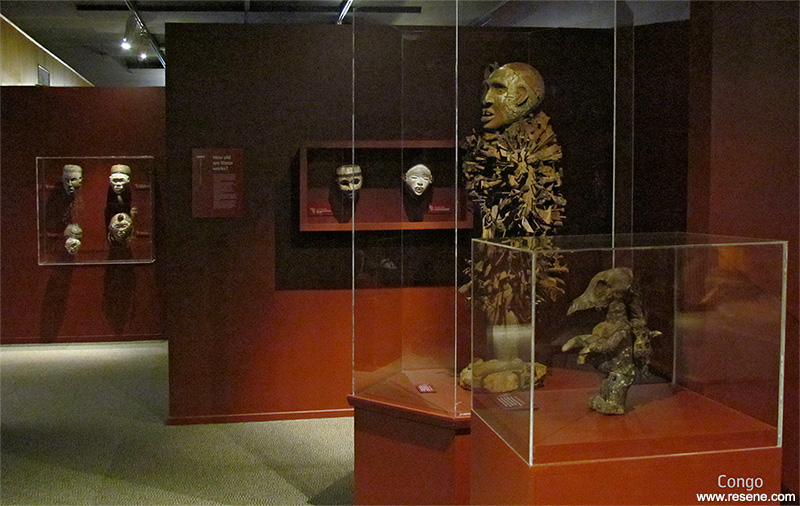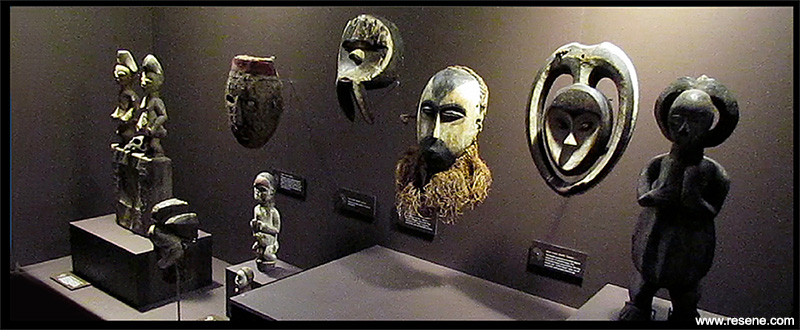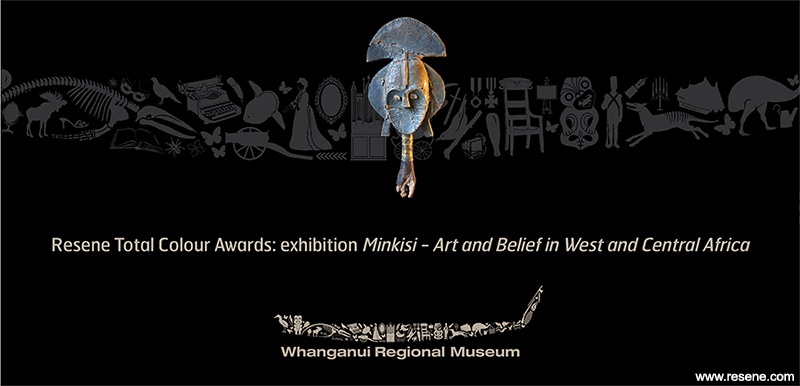Whanganui Regional Museum
The exhibition is dramatically presented through the nature of West and Central African objects and the use of strong design in ‘African’ landscape colours and strategic lighting.

Minkisi – Art and Belief in West and Central Africa is a dramatic presentation of masks and statues from West and Central Africa, delivering a message about cultures, traditions, histories and beliefs that are widely divergent from our own. We offer visitors opportunities to learn, to admire and to think about the place of Africa in the world, and contrast it to the place of our own country in the world. Minkisi is created from a collection of West and Central African statues and masks, owned by Whanganui collector Desmond Bovey, who lived in France for thirty years and visited Africa often. Dramatic and dynamic, Minkisi has great pulling power and provides a new and exciting range of experiences for discerning museum visitors. Desmond Bovey provides not only the use of his collection but also his design and graphic skills and his considerable knowledge of West and Central Africa.

The masks and statues in the collection are from Ivory Coast and Burkina Faso in the west, through Nigeria, Cameroon and Gabon, to the Congo coast and basin. Minkisi is a word that refers generically to statues from the latter region. Often in human or animal form, they contain a spirit, working through ceremony and ritual for the good of an individual or clan. It is an evocative word that captures the nature of Central Africa and takes visitors on a visual and emotional journey.
The exhibition is dramatically presented through the nature of West and Central African objects and the use of strong design in ‘African’ landscape colours and strategic lighting. A hierarchical typography and label plan delineate sections, themes and geography and aid in both conscious and subliminal visitor navigation. Design and style is consistent and always used in association with Minkisi.

This exhibition was originally scheduled to run from October 2012 to August 2013. Response and visitation has been so strong, however, that the Museum extended the season to May 2014, ensuring much wider visitation coverage.
A programme of public events and activities includes guest curator floor talks; guided curatorial tours; discussion panels on topics such as colonialism, neocolonialism, and African art and belief; special sessions for UCOLS arts students; films about West and Central Africa, both factual and fictional; and explorations of African music, literature and traditions through a series of workshops and lectures.

A comprehensive curriculum-based school education programme offers agespecific lessons and experiences using Minkisi as a vehicle to explore cultural thought and practice around the world.
We chose a rich, warm colour palette to evoke an atmosphere, to create mood and drama, identify Africa through colour, colour-code and define geographic and cultural zones of West and Central Africa and provide a background that displays African art to its best advantage.

We deliberately kept our palette to three strong colours so that we would not distract from or overpower the masks and statues.
We chose Resene Rusty Nail for West Africa, the visitor’s first contact with the exhibition. This shade has an organic richness that refers to the earthy ochre tones of the savannah, and also acts as an introduction to the darker colours to come.

For Cameroon and Gabon we chose Resene Barista. This region has produced some of the most refined and enigmatic sculpture in Africa. To dramatise the solemn power of these statues and masks, this dark and very African shade, with subdued lighting, gives a tone-on-tone richness that dramatises these special pieces.
The Congo section contains the largest and most spectacular figures in the exhibition. A red was the obvious choice. The Bakongo people valued red above all colours. Resene Lonestar works as an expression of sacredness, mystery and rank. It also links to the rich red earth of the Congo region.

A challenge was to ensure that these colours would glow as effectively behind glass or perspex as they did on uncovered walls. Our solution was to combine localised interior case lights with very few exterior spots, creating pools of colour, which ensured continuing visual warmth and power.
Architectural specifier: Eric Dorfman, Museum Director, Whanganui Regional Museum
Client: Whanganui Regional Museum
Colour selection: Desmond Bovey, Guest Curator
Curator: Libby Sharpe
Exhibition officer: Dale Hudson
Photographer: Desmond Bovey, Guest Curator
Project: Resene Total Colour Awards 2013
Resene case studies/awards project gallery
View case studies that have used Resene products including many from our Resene Total Colour Awards. We hope these projects provide inspiration for decorating projects of your own... view projects
Total Colour Award winners:
2023 |
2022 |
2021 |
2020 |
2019 |
2018 |
2017 |
2016 |
2015 |
2014 |
2013 |
2012 |
2011 |
2010 |
Entry info
Latest projects | Project archive | Resene news archive | Colour chart archive